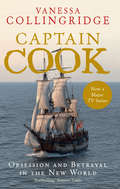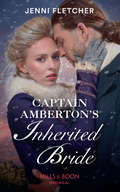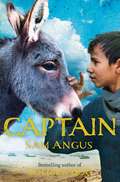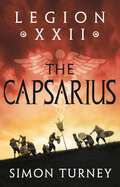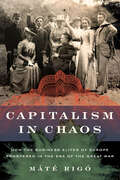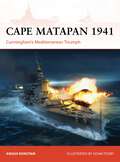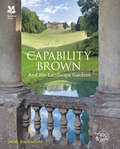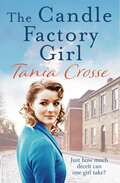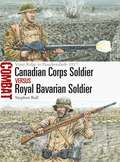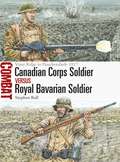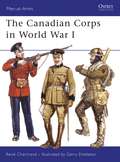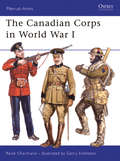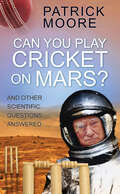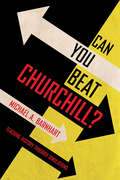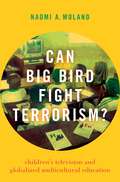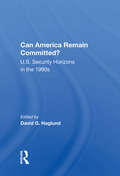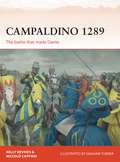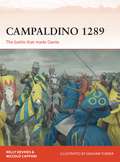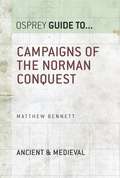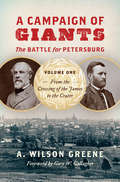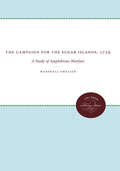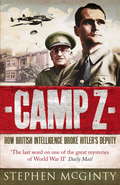- Table View
- List View
Captain Cook: The Life, Death And Legacy Of History's Greatest Explorer (Lyons Press Series)
by Vanessa CollingridgeA uniquely woven story encompassing three separate centuries and three different lives. Captain Cook, best known for his heroic voyages through the Pacific Ocean, is brought to life in vivid detail. We follow his humble beginnings as the son of a farm labourer, through his convention-shattering treatment of the indigenous groups he met on his travels, and then onto his final tragic voyage which signalled the end of his revered reputation. One hundred years on from the death of Cook, another great man, George Collingridge begins his own adventure. He, like Cook was oblivious to the implications his journey would have. Along the way he unfolds ancient maps, secret tales and unearths hidden lands and buried treasure. He is also said to have realised that it was not Cook who discovered Australia - it was the Portugese. This firm belief was the eventual cause of his self-destruction.Another hundred years later Vanessa Collingridge, is searching for books on her lifelong hero Captain Cook in a university library. She discovers the name of a distant cousin, George Collingridge, in a dusty card index. And so a new journey of discovery begins - in the footsteps of her hero and his nemesis.
Captain Amberton's Inherited Bride: In The Sheriff's Protection In Thrall To The Enemy Commander Captain Amberton's Inherited Bride (Mills And Boon Historical Ser.)
by Jenni Fletcher‘Marry me… …And you’ll have your freedom.’
Captain: Marco Polo; Ibn Battuta; Christopher Columbus; Bartolomeu Diaz Vasco Da Gama; Ferdinand Magellan; Captain Cook Lewis And Clark; Livingstone And Stanley; The Apollo Mission
by Sam AngusIt's 1915 and British troops are about to sail to Gallipoli. Billy is the youngest soldier in his platoon and is teased for not being old enough to drink or shave. The truth is, at 15 he's not old enough to be a soldier either, and he's terrified of the war he's about to fight. Then he meets Captain, a refugee boy, and his donkey, Hey-ho. Together they teach Billy what it means to be brave, loyal and fearless, and above all what it means to be a friend.
The Capsarius (Legion XXII)
by Simon TurneyWarrior and combat medic, Titus Cervianus, must lead a legion and quell the uprisings in Egypt in this thrilling Roman adventure from Simon Turney. Titus Cervianus is no ordinary soldier. And the Twenty Second is no ordinary legion...Egypt. 25 BC. A former surgeon from the city of Ancyra, Titus Cervianus is now a capsarius – a combat medic. He is a pragmatist, a scientist – and deeply unpopular with his legion, the Twenty Second Deiotariana.The Twenty Second have been sent to deal with uprisings in Egypt. Founded as the private army of one of Rome's most devoted allies, their ways are not the same as the other legions', which sets them apart and causes friction with their fellow soldiers.Marching into the unknown, Cervianus will find unexpected allies: a local cavalryman and a troublesome lunatic. Both will be of critical importance as the young medic marches through the searing sands of the south, finding forbidden temples, hidden assassins, and worst of all, the warrior queen of Kush...Reviews for The Capsarius'Brings a whole new dimension to the genre... Recommended' Historical Novel Society'A blistering epic brimming with tension, mystery and adventure!' Gordon DohertyReviews for Simon Turney'A page turner from beginning to end... A damn fine read' Ben Kane'First-rate Roman fiction' Matthew Harffy
Capitalism in Chaos: How the Business Elites of Europe Prospered in the Era of the Great War
by Máté RigóCapitalism in Chaos explores an often-overlooked consequence and paradox of the First World War—the prosperity of business elites and bankers in service of the war effort during the destruction of capital and wealth by belligerent armies. This study of business life amid war and massive geopolitical changes follows industrialists and policymakers in Central Europe as the region became crucially important for German and subsequently French plans of economic and geopolitical expansion in the late nineteenth and early twentieth centuries. Based on extensive research in sixteen archives, five languages, and four states, Máté Rigó demonstrates that wartime destruction and the birth of "war millionaires" were two sides of the same coin. Despite the recent centenaries of the Great War and the Versailles peace treaties, knowledge of the overall impact of war and border changes on business life remains sporadic, based on scant statistics and misleading national foci. Consequently, most histories remain wedded to the viewpoint of national governments and commercial connections across national borders.Capitalism in Chaos changes the static historical perspective by presenting Europe's East as the economic engine of the continent. Rigó accomplishes this paradigm shift by focusing on both supranational regions—including East-Central and Western Europe—as well as the eastern and western peripheries of Central Europe, Alsace-Lorraine and Transylvania, from the 1870s until the 1920s. As a result, Capitalism in Chaos offers a concrete, lively history of economics during major world crises, with a contemporary consciousness toward inequality and disparity during a time of collapse.
Cape Matapan 1941: Cunningham’s Mediterranean Triumph (Campaign #397)
by Angus KonstamThe first ever illustrated study of the largest and most significant clash between the Royal Navy and the Italian Regia Marina.The Battle of Matapan witnessed the first use of decisive new technologies to bring about a stunning British victory over the Italian Navy. The Allies had tapped into the Ultra coded messages sent by the Axis powers, and the battle witnessed the use of radar and carrier-based air strikes to bring about a critical night action. The result was the most decisive engagement of the Mediterranean naval war.Written by renowned naval historian Angus Konstam, this book offers for the first time a unique and fully illustrated exploration of the battle. It also examines why, despite the emphatic and decisive Royal Navy victory, the Allies failed to capitalize on the strategic advantage earned in the months that followed. Battlescene artworks bring to life the cruiser clashes early on 28 March off Gavdos, the Fleet Air Arm attacks on the Italian fleet, and the 28/29 March night action that resulted in the destruction of Admiral Carlo Cattaneo's ships – Italy's worst naval defeat. The progress of the action from the initial Operation Gaudo sweep by Italy's powerful battle fleet towards Crete (aimed at disrupting Allied convoys) to the events of the climactic battle itself is revealed in detailed maps.
Cape Matapan 1941: Cunningham’s Mediterranean Triumph (Campaign #397)
by Angus KonstamThe first ever illustrated study of the largest and most significant clash between the Royal Navy and the Italian Regia Marina.The Battle of Matapan witnessed the first use of decisive new technologies to bring about a stunning British victory over the Italian Navy. The Allies had tapped into the Ultra coded messages sent by the Axis powers, and the battle witnessed the use of radar and carrier-based air strikes to bring about a critical night action. The result was the most decisive engagement of the Mediterranean naval war.Written by renowned naval historian Angus Konstam, this book offers for the first time a unique and fully illustrated exploration of the battle. It also examines why, despite the emphatic and decisive Royal Navy victory, the Allies failed to capitalize on the strategic advantage earned in the months that followed. Battlescene artworks bring to life the cruiser clashes early on 28 March off Gavdos, the Fleet Air Arm attacks on the Italian fleet, and the 28/29 March night action that resulted in the destruction of Admiral Carlo Cattaneo's ships – Italy's worst naval defeat. The progress of the action from the initial Operation Gaudo sweep by Italy's powerful battle fleet towards Crete (aimed at disrupting Allied convoys) to the events of the climactic battle itself is revealed in detailed maps.
Capability Brown: And His Landscape Gardens (National Trust History And Heritage Ser.)
by Sarah RutherfordOne of the most remarkable men of the 18th century, Lancelot ‘Capability’ Brown was known to many as ‘The Omnipotent Magician’ who could transform unpromising countryside into beautiful parks that seemed to be only the work of nature.
The Candle Factory Girl: A gritty story of deceit and betrayal... (Banbury Street #1)
by Tania Crosse1930's London - A backstreet saga full of hopes, dreams and the fight for survival. Perfect for the fans of Rosie Clarke and Lindsey Hutchinson. Work at Price's Candle Factory in Battersea is tedious for intelligent, seventeen-year-old Hillie Hardwick, but she knows she is lucky to have a job at all. Her home life is no better, as she constantly battles with her exacting and bullying father in order to protect her mother and five younger siblings from his abuse. Her only solace is her loving relationship with the chaotic Parker family and her best friend, Gert Parker. When matters violently escalate for Hillie, smitten Jack-the-Lad Jimmy Baxter seems her only salvation. But could this be the biggest mistake of her life, and should she be looking for protection nearer home? A story that crackles with unease where courage and friendship are the only hope. What readers are saying: 'This is a great saga that packs so much emotion and passion into it that you are swept away' Dash Fan Book Reviews. 'This is a wonderful saga... In my opinion, this is her best book yet. I have no hesitation whatsoever in recommending this one as a truly great read' Good 'N Ready. 'I really enjoyed this book, it has some great characters and I loved the setting!' Donna's Book Blog. 'For me it was a fast read, really well written storyline with characters you get invested in' Holly Senecal, NetGalley.
Canadian Corps Soldier vs Royal Bavarian Soldier: Vimy Ridge to Passchendaele 1917 (Combat)
by Adam Hook Stephen BullIn 1917 the soldiers of the Canadian Corps would prove themselves the equal of any fighting on the Western Front, while on the other side of the wire, the men of the Royal Bavarian Army won a distinguished reputation in combat. Employing the latest weapons and pioneering tactics, these two forces would clash in three notable encounters: the Canadian storming of Vimy Ridge, the back-and-forth engagement at Fresnoy and at the sodden, bloody battle of Passchendaele. Featuring carefully chosen archive photographs and specially commissioned artwork, this study assesses these three hard-fought battles in 1917 on the Western Front, and offers a new take on the evolving nature of infantry combat in World War I.
Canadian Corps Soldier vs Royal Bavarian Soldier: Vimy Ridge to Passchendaele 1917 (Combat)
by Adam Hook Stephen BullIn 1917 the soldiers of the Canadian Corps would prove themselves the equal of any fighting on the Western Front, while on the other side of the wire, the men of the Royal Bavarian Army won a distinguished reputation in combat. Employing the latest weapons and pioneering tactics, these two forces would clash in three notable encounters: the Canadian storming of Vimy Ridge, the back-and-forth engagement at Fresnoy and at the sodden, bloody battle of Passchendaele. Featuring carefully chosen archive photographs and specially commissioned artwork, this study assesses these three hard-fought battles in 1917 on the Western Front, and offers a new take on the evolving nature of infantry combat in World War I.
The Canadian Corps in World War I (Men-at-Arms)
by Gerry Embleton René ChartrandThis book describes the organization, lists the units and illustrates the uniforms and equipment of the four Canadian divisions which earned an elite reputation on the Western Front in 1915-18. Canada's 600,000 troops of whom more than 66,000 died and nearly 150,000 were wounded represented an extraordinary contribution to the British Empire's struggle. On grim battlefields from the Ypres Salient to the Somme, and from their stunning victory at Vimy Ridge to the final triumphant 'Hundred Days' advance of autumn 1918, Canada's soldiers proved themselves to be a remarkable army in their own right, founding a national tradition.
The Canadian Corps in World War I (Men-at-Arms)
by Gerry Embleton René ChartrandThis book describes the organization, lists the units and illustrates the uniforms and equipment of the four Canadian divisions which earned an elite reputation on the Western Front in 1915-18. Canada's 600,000 troops of whom more than 66,000 died and nearly 150,000 were wounded represented an extraordinary contribution to the British Empire's struggle. On grim battlefields from the Ypres Salient to the Somme, and from their stunning victory at Vimy Ridge to the final triumphant 'Hundred Days' advance of autumn 1918, Canada's soldiers proved themselves to be a remarkable army in their own right, founding a national tradition.
Can You Play Cricket on Mars?: And Other Scientific Questions Answered
by Sir Patrick MooreCan You Play Cricket on Mars? answers questions like: is there a dark side to the Moon? what happens when a comet hits the Sun? do the Martian canals have any water in them? is the Moon hot inside? what would happen if the Sun were to collide with a black hole? Mars has polar ice caps: could polar bears live there? if I could go back to the time of the dinosaurs, would the sky look the same as it does today? and many more.
Can You Beat Churchill?: Teaching History through Simulations
by Michael A. BarnhartHow do you get students to engage in a historical episode or era? How do you bring the immediacy and contingency of history to life? Michael A. Barnhart shares the secret to his award-winning success in the classroom with Can You Beat Churchill?, which encourages role-playing for immersive teaching and learning. Combating the declining enrollment in humanities classes, this innovative approach reminds us how critical learning skills are transmitted to students: by reactivating their curiosity and problem-solving abilities.Barnhart provides advice and procedures, both for the use of off-the-shelf commercial simulations and for the instructor who wishes to custom design a simulation from scratch. These reenactments allow students to step into the past, requiring them to think and act in ways historical figures might have. Students must make crucial or dramatic decisions, though these decisions need not align with the historical record. In doing so, they learn, through action and strategic consideration, the impact of real individuals and groups of people on the course of history. There is a quiet revolution underway in how history is taught to undergraduates. Can You Beat Churchill? hopes to make it a noisy one.
Can Big Bird Fight Terrorism?: Children's Television and Globalized Multicultural Education
by Naomi A. MolandSesame Street has taught generations of Americans their letters and numbers, and also how to better understand and get along with people of different races, faiths, ethnicities, and temperaments. But the show has a global reach as well, with more than thirty co-productions of Sesame Street that are viewed in over 150 countries. In recent years, the United States Agency for International Development (USAID) has provided funding to the New York-based Sesame Workshop to create international versions of Sesame Street. Many of these programs teach children to respect diversity and tolerate others, which some hope will ultimately help to build peace in conflict-affected societies. In fact, the U.S. government has funded local versions of the show in several countries enmeshed in conflict, including Afghanistan, Kosovo, Pakistan, Jordan, and Nigeria. Can Big Bird Fight Terrorism? takes an in-depth look at the Nigerian version, Sesame Square, which began airing in 2011. In addition to teaching preschool-level academic skills, Sesame Square seeks to promote peaceful coexistence-a daunting task in Nigeria, where escalating ethno-religious tensions and terrorism threaten to fracture the nation. After a year of interviewing Sesame creators, observing their production processes, conducting episode analysis, and talking to local educators who use the program in classrooms, Naomi Moland found that this child-focused use of soft power raised complex questions about how multicultural ideals translate into different settings. In Nigeria, where segregation, state fragility, and escalating conflict raise the stakes of peacebuilding efforts, multicultural education may be ineffective at best, and possibly even divisive. This book offers rare insights into the complexities, challenges, and dilemmas inherent in soft power attempts to teach the ideals of diversity and tolerance in countries suffering from internal conflicts.
Can Big Bird Fight Terrorism?: Children's Television and Globalized Multicultural Education
by Naomi A. MolandSesame Street has taught generations of Americans their letters and numbers, and also how to better understand and get along with people of different races, faiths, ethnicities, and temperaments. But the show has a global reach as well, with more than thirty co-productions of Sesame Street that are viewed in over 150 countries. In recent years, the United States Agency for International Development (USAID) has provided funding to the New York-based Sesame Workshop to create international versions of Sesame Street. Many of these programs teach children to respect diversity and tolerate others, which some hope will ultimately help to build peace in conflict-affected societies. In fact, the U.S. government has funded local versions of the show in several countries enmeshed in conflict, including Afghanistan, Kosovo, Pakistan, Jordan, and Nigeria. Can Big Bird Fight Terrorism? takes an in-depth look at the Nigerian version, Sesame Square, which began airing in 2011. In addition to teaching preschool-level academic skills, Sesame Square seeks to promote peaceful coexistence-a daunting task in Nigeria, where escalating ethno-religious tensions and terrorism threaten to fracture the nation. After a year of interviewing Sesame creators, observing their production processes, conducting episode analysis, and talking to local educators who use the program in classrooms, Naomi Moland found that this child-focused use of soft power raised complex questions about how multicultural ideals translate into different settings. In Nigeria, where segregation, state fragility, and escalating conflict raise the stakes of peacebuilding efforts, multicultural education may be ineffective at best, and possibly even divisive. This book offers rare insights into the complexities, challenges, and dilemmas inherent in soft power attempts to teach the ideals of diversity and tolerance in countries suffering from internal conflicts.
Can America Remain Committed?: U.s. Security Horizons In The 1990s
by David G. HaglundThe twelve months that spanned the period between the early springtimes of 1991 and 1992 may well turn out to constitute the most important year for American foreign and security policy in half a century. Encasing the dawning of a new and different security era, like macabre parentheses, were two columns of black smoke-that of 1991 over the newly liberated Kuwait, and that of 1992 over the embattled district of South-Central Los Angeles. Within these acrid temporal brackets unfolded a set of developments of utmost significance for American foreign and security policy and for the very meaning of the country's external commitments.
Can America Remain Committed?: U.s. Security Horizons In The 1990s
by David G. HaglundThe twelve months that spanned the period between the early springtimes of 1991 and 1992 may well turn out to constitute the most important year for American foreign and security policy in half a century. Encasing the dawning of a new and different security era, like macabre parentheses, were two columns of black smoke-that of 1991 over the newly liberated Kuwait, and that of 1992 over the embattled district of South-Central Los Angeles. Within these acrid temporal brackets unfolded a set of developments of utmost significance for American foreign and security policy and for the very meaning of the country's external commitments.
Campaldino 1289: The battle that made Dante (Campaign #324)
by Bounford.com Bounford.com Mr Graham Turner Paul Kime Kelly DeVries Niccolò CapponiCampaldino is one of the important battles between the Guelphs and Ghibellines - the major political factions in the city states of central and northern Italy. It heralded the rise of Florence to a dominant position over the area of Tuscany and was one of the last occassions when the Italian city militias contested a battle, with the 14th century seeing the rise of the condottiere in Italy's Wars.In this highly illustrated new study, renowned medieval historians Kelly De Vries and Niccolò Capponi have uncovered new material from the battlefield itself, as well as using all the available sources, to breathe new life into this colourful and fascinating battle.
Campaldino 1289: The battle that made Dante (Campaign)
by Graham Turner Bounford.com Bounford.com Paul Kime Kelly DeVries Niccolò CapponiCampaldino is one of the important battles between the Guelphs and Ghibellines - the major political factions in the city states of central and northern Italy. It heralded the rise of Florence to a dominant position over the area of Tuscany and was one of the last occassions when the Italian city militias contested a battle, with the 14th century seeing the rise of the condottiere in Italy's Wars.In this highly illustrated new study, renowned medieval historians Kelly De Vries and Niccolò Capponi have uncovered new material from the battlefield itself, as well as using all the available sources, to breathe new life into this colourful and fascinating battle.
Campaigns of the Norman Conquest (Guide to... #12)
by Matthew BennettThis book provides a full introduction to the Norman Conquest, an event which resulted in dramatic changes to the nation's aristocracy, church and administration. It brought a new language and cultural influences and revolutionised military architecture with the introduction of the castle. This profound impact was not brought about as the result of a single battle and it took a five-year war for William to establish control over his new kingdom. The campaigns are studied in detail, with maps showing how William's energy and strategic intelligence enabled him to defeat his formidable opponents and create a new order.
A Campaign of Giants--The Battle for Petersburg: Volume 1: From the Crossing of the James to the Crater (Civil War America)
by A. Wilson GreeneGrinding, bloody, and ultimately decisive, the Petersburg Campaign was the Civil War's longest and among its most complex. Ulysses S. Grant and Robert E. Lee squared off for more than nine months in their struggle for Petersburg, the key to the Confederate capital at Richmond. Featuring some of the war's most notorious battles, the campaign played out against a backdrop of political drama and crucial fighting elsewhere, with massive costs for soldiers and civilians alike. After failing to bull his way into Petersburg, Grant concentrated on isolating the city from its communications with the rest of the surviving Confederacy, stretching Lee's defenses to the breaking point. When Lee's desperate breakout attempt failed in March 1865, Grant launched his final offensives that forced the Confederates to abandon the city on April 2, 1865. A week later, Lee surrendered at Appomattox Court House.Here A. Wilson Greene opens his sweeping new three-volume history of the Petersburg Campaign, taking readers from Grant's crossing of the James in mid-June 1864 to the fateful Battle of the Crater on July 30. Full of fresh insights drawn from military, political, and social history, A Campaign of Giants is destined to be the definitive account of the campaign. With new perspectives on operational and tactical choices by commanders, the experiences of common soldiers and civilians, and the significant role of the United States Colored Troops in the fighting, this book offers essential reading for all those interested in the history of the Civil War.
The Campaign for the Sugar Islands, 1759: A Study of Amphibious Warfare (Published by the Omohundro Institute of Early American History and Culture and the University of North Carolina Press)
by Marshall SmelserIn the battle for empire that was the Seven Years' War, France's Sugar Islands, Guadeloupe and Martinique, were stakes as important as the Dominion of Canada. This book sketches the background strategy that led William Pitt to send an expedition to capture them, but it is chiefly the story of the campaign itself.Originally published in 1955.A UNC Press Enduring Edition -- UNC Press Enduring Editions use the latest in digital technology to make available again books from our distinguished backlist that were previously out of print. These editions are published unaltered from the original, and are presented in affordable paperback formats, bringing readers both historical and cultural value.
Camp Z: How British Intelligence Broke Hitler's Deputy
by Stephen McGintyOn 10 May 1941, Rudolf Hess, then the Deputy Führer, parachuted over Renfrewshire in Scotland on a mission to meet with the Duke of Hamilton, ostensibly to broker a peace deal with the British government. After being held in the Tower of London, he was transferred to Mytchett Place near Aldershot on 20 May, under the codename of 'Z'. The house was fitted with microphones and sound recording equipment, guarded by a battalion of soldiers and codenamed 'Camp Z'.Churchill's instructions were that Hess should be strictly isolated, with every effort taken to get any information out of him that could help change the course of the Second World War. Stephen McGinty uses documentation, contemporaneous reports, diaries, letters and memos to piece together a riveting account of the claustrophobia, paranoia and high-stakes gamesmanship being played out in an English country house. CAMP Z is a 'locked room mystery' where the 'locked room' is a man's mind that no one can conclude, with any degree of confidence, is sane.
